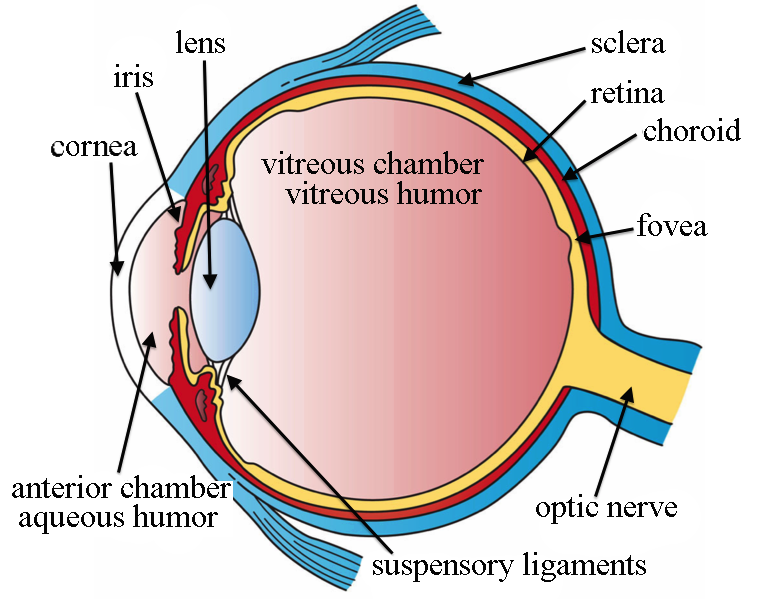

Vision Center is funded by our readers. We may earn commissions if you purchase something via one of our links.
In this articleThe sclera is commonly known as the white of the eye. It’s the opaque tissue that surrounds your entire eyeball, except for the clear cornea (the covering in the front of your eye). The sclera is strong, fibrous tissue made mostly of collagen and elastic fibers.

The bulbar conjunctiva covers the front part of your sclera. This is a thin layer of tissue with blood vessels.
The sclera’s dense connective tissue forms the supporting wall of the human eyeball and gives it its white color.
The sclera and intraocular pressure maintain the shape and structural integrity of the eyeball. It also protects the inner structures of your eye from trauma.
Most of your eyeball is filled with a gel-like fluid called the vitreous humor. Your extraocular muscles, which control your eye movements, attach firmly to the sclera.

Several conditions can affect the sclera. Some problems appear to affect the sclera but actually affect the overlying bulbar conjunctiva. The appearance can be misleading because the bulbar conjunctiva is mostly transparent.
Sclera conditions include:
Episcleritis is an inflammation of the outermost layer of the sclera. Symptoms include:
Most cases are sectoral, meaning only a section of the sclera is affected. In diffuse cases, the entire sclera can be affected. Episcleritis may be associated with rheumatoid arthritis, lupus, Crohn’s disease, Behcet’s disease, or gout.
Scleritis is inflammation of the sclera. It can be similar to episcleritis, but more serious and painful. Scleritis often causes intense pain that worsens with eye movement. It can be caused by an injury or underlying inflammatory condition.
If left untreated, this condition is more severe than episcleritis and may cause permanent damage and vision loss.
Scleromalacia perforans is a rare and severe condition. Your immune system attacks the sclera tissue, causing significant thinning and bulging.
Because of thinning, the underlying uveal tissue is visible. This gives the sclera a bluish appearance. In rare cases, the eye can rupture. Scleromalacia perforans is often associated with older women with long-standing rheumatoid arthritis.
Scleral icterus is jaundice that affects the eyes. It gives the whites of the eyes a yellow appearance. The name is not entirely accurate because it affects the conjunctiva, not the sclera. It is sometimes known as conjunctival icterus.
This condition occurs when your body has high bilirubin levels. Bilirubin is a yellowish substance that is produced from the breakdown of red blood cells. Liver disease or other serious health conditions can cause high bilirubin levels.
Scleral plaques are blue-gray calcified plaques that appear on the sclera. They are related to old age. They are benign and do not cause any symptoms.
Blue sclera occurs when the sclera thins, exposing the dark, uveal tissue underneath (where it gets its blue color).
The cause may be congenital (present at birth). Osteogenesis imperfecta (brittle bone disease) can cause it. Blue sclera is also associated with Marfan syndrome, Ehlers-Danlos syndrome, and Loeys-Dietz syndrome.
Acquired blue sclera may be a sign of severe iron deficiency.
Other conditions present at birth that may affect the sclera. Some of these are harmless. Others are more severe and may affect vision or eye health.
Ocular melanosis is pigmentation of the conjunctiva overlying the sclera. They typically look like flat, brown spots on the white part of the eye, similar to a freckle on the skin. Melanosis can be congenital or acquired.
There are two acquired forms, primary and secondary acquired melanosis:
Nevus of Ota is a congenital condition. It causes hyperpigmentation of the eye, eyelids, and other surrounding areas. The pigment often appears blue or brown.
Typically, the nevus doesn’t require treatment. Some people desire laser therapy to lighten the spots for cosmetic reasons. Nevus of Ota is associated with a higher risk of glaucoma and, in rare cases, eye melanoma.
Ectasia is a congenital thinning and bulging of the sclera.
The thinning usually occurs near the limbus and also affects the cornea. The staphyloma often presents with a blue appearance.
Staphylomas can also develop on the back of the eye, particularly in people with high myopia (nearsightedness).
Colobomas occur when there is some tissue missing in the eye at birth. This results in the incomplete formation of a particular structure of the eye.
Colobomas can affect the eyelid, iris, lens, optic nerve, choroid, and retina. The optic nerve, choroidal, or retinal colobomas can cause scleral thinning and staphylomas.
Contact your healthcare provider if you notice any changes to your vision or the appearance of your sclera.
Concerning signs and symptoms to look out for include:
The following procedures treat problems with the sclera:
Scleral expansion is a somewhat controversial procedure designed to treat presbyopia. 4 Presbyopia is the loss of the ability to focus up close with age.
The surgery involves inserting four plastic pieces into the sclera between the eye muscles. This technology is still improving, and some researchers feel this procedure could become the gold standard in presbyopia treatment.
A scleral buckle procedure is performed to repair a retinal detachment.
During the surgery, a doctor uses cryopexy (freezing therapy) to seal your retina to the eye. Then they’ll place a silicone or plastic band around your eyeball (the scleral buckle). This helps the retina stay in place, and the buckle is permanent.
The sclera is known as the white of the eye. It helps maintain your eye shape and protects your inner structures from eye trauma.
Different problems may affect the sclera, there are procedures and surgeries available to manage them. If you experience any symptoms of these problems, consult your doctor immediately.